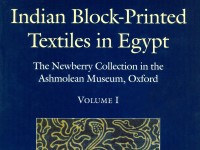Indian Block-Printed Textiles in Egypt: The Newberry Collection in the Ashmolean Museum, Oxford
A catalogue of Newberry's block-printed textiles by Ruth Barnes (published Oxford, 1997).

Publications online: 1180 objects
- Reference URL
Actions
Textile fragment with lotus vines, medallions, rosettes, and inscription
-
Literature notes
Large, continuous lotus vines are arranged to form medallions, each with an elaborate rosette in the centre. Lotus blossoms and ornate leaves emerge from the vines. In addition there is the beginning of a border with narrow bands of rosettes and script. The resist defines the design, the background is blue.
Radiocarbon dating has shown this fragment to be of late 10th- or 11th-century date; the result was 1010 CE +/- 55. Two fragments found at Quseir al-Qadim have a similar lotus vine motif (see Vogelsang-Eastwood 1990: Cat. nos. 27 & 28). In her catalogue description, Vogelsang-Eastwood cannot identify the pattern, but the better state of preservation in the Newberry fragment, as well as the textile illustrated by Pfister (pl. XXVa), help to define the design beyond doubt. The inscription reads 'to its owner...'; see Cat. no. 144 [EA1990.152]. The size of the block used was 14.5 cm. x 12.5 cm. Also published in Barnes 1992b: 10. -
Details
- Associated place
-
Asia › India › west India › Gujarat (place of creation)
- Date
- 10th century - 1st half of the 11th century AD
- Material and technique
- cotton, block-printed with resist, and dyed blue
- Dimensions
-
71 x 18 cm max. (length x width)
along length/width 12 / 12 threads/cm (thread count)
block 14.5 x 12.5 cm estimated (length x width)
- Material index
- Technique index
-
assembled › woven › plain woven,woven › plain woven,dyed › resist dyed,coloured › dyed › resist dyed
- Object type index
- No. of items
- 1
- Credit line
- Presented by Professor Percy Newberry, 1941.
- Accession no.
- EA1990.247
-
Further reading
Barnes, Ruth, Indian Block-Printed Textiles in Egypt: The Newberry Collection in the Ashmolean Museum, Oxford, 2 vols (Oxford: Clarendon Press, 1997), no. 238 on p. 68 (vol. ii), vol. ii pp. 92 & 163, illus. vol. ii p. 68 fig. 238, vol. i illus. 9, & vol. i pl. 17
Pfister, R., Les toiles imprimées de Fostat et l'Hindoustan (Paris: Les Éditions d'Art et d'Histoire, 1938), cat. pl. XXV a, illus. 69
Vogelsang-Eastwood, Gillian, The Resist Dyed Textiles from Quseir al-Qadim, Egypt (Paris: Association pour l'étude et la documentation des textiles d'Asie, 1990), illus. 43 & 99
Location
-
- currently in research collection
Objects are sometimes moved to a different location. Our object location data is usually updated on a monthly basis. Contact the Jameel Study Centre if you are planning to visit the museum to see a particular object on display, or would like to arrange an appointment to see an object in our reserve collections.
Galleries
Publications online
-

Indian Block-Printed Textiles in Egypt: The Newberry Collection in the Ashmolean Museum, Oxford
Large, continuous lotus vines are arranged to form medallions, each with an elaborate rosette in the centre. Lotus blossoms and ornate leaves emerge from the vines. In addition there is the beginning of a border with narrow bands of rosettes and script. The resist defines the design, the background is blue.
Radiocarbon dating has shown this fragment to be of late 10th- or 11th-century date; the result was 1010 CE +/- 55. Two fragments found at Quseir al-Qadim have a similar lotus vine motif (see Vogelsang-Eastwood 1990: Cat. nos. 27 & 28). In her catalogue description, Vogelsang-Eastwood cannot identify the pattern, but the better state of preservation in the Newberry fragment, as well as the textile illustrated by Pfister (pl. XXVa), help to define the design beyond doubt. The inscription reads 'to its owner...'; see Cat. no. 144 [EA1990.152]. The size of the block used was 14.5 cm. x 12.5 cm. Also published in Barnes 1992b: 10.
Notice
Object information may not accurately reflect the actual contents of the original publication, since our online objects contain current information held in our collections database. Click on 'buy this publication' to purchase printed versions of our online publications, where available, or contact the Jameel Study Centre to arrange access to books on our collections that are now out of print.
© 2013 University of Oxford - Ashmolean Museum


